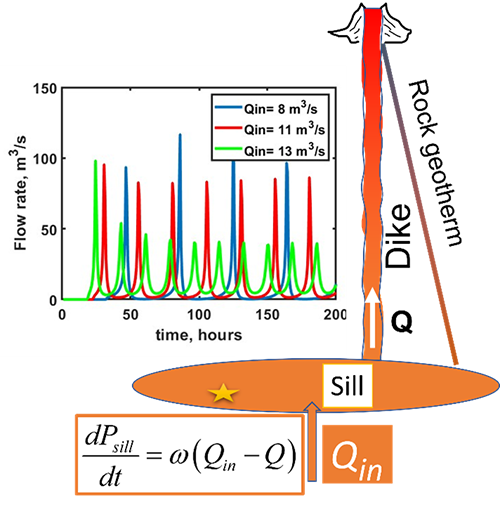Numerical simulation of non-isothermal flows in dikes

SEMINARIO:
Speaker: Oleg Melnik
Affiliation: University Grenoble Alpes, ISTerre, Grenoble, France
Date: 19th September 2023
Time: 11:00 AM
Hosted by: INGV Sezione di Pisa
Abstract
The talk covers two different models for non-isothermal flows in dikes: a model of periodic magma discharge at Fagradalsfjall volcano (Iceland) and of silicic dikes ascend with multiple volatile species.
Fagradalsfjall eruption showed a remarkable pulsatory magma discharge activity in Jul-Aug 2021, with a characteristic timescale of ~36 hours (with cycles varying from 17 to 76 hours). We propose that the pulsatory activity is caused by the dynamics of magma flow in a feeding dike. The model assumes a sill-dike system in purely elastic wall rocks, Newtonian temperature-dependent magma viscosity, and heat transfer from the magma following Newton’s law. Elastic displacements of host rocks are calculated by means of the analytical solution for an elliptic cavity. The influx rate of the magma into the sill is constant. For reasonable values of governing parameters, the system shows pulsatory activity in accordance with the observed timescales. During low discharge rate magma viscosity in the upper part of the dike increases dramatically, magma flow stops, and the dike starts to inflate at depth storing large amounts of magma. As the pressure increases the flow of the fresh hot magma destroys the plug and discharge episode occurs. The dike deflates and the flow rate decreases leading to consequent cooling of the magma and blockage of the dike. Silicic magmas ascending in dikes undergo complicated physical and chemical transformations as it propagates through the Earth’s crust. We introduce a mathematical model that accounts for the presence of multiple volatile species (H2O and CO2) in silicic magma, bubble growth, heat transfer, crystallization, and latent heat release. The model’s outcomes indicate rapid ascent times (hours to days) from a deep source, and a significant increase in viscosity near the surface due to cooling and degassing induces crystallization, resulting in the dike stagnation and solidification. Faster dike propagation and shallower stopping depth are influenced by higher initial water content, temperature, and a greater mass of buoyant magma within the dike. Simulations suggest a plausible mechanism for the transportation of deep volatiles to shallow intrusions associated with porphyry ore deposits.


Devi effettuare l'accesso per postare un commento.